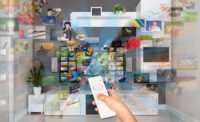Afairly well known meme in the recording industry depicts a dog in four various stages of grooming. The photos include titles that refer to the audio process: during the “mixing” and “mastering” stages, the animal is depicted as going from shaggy and unkempt to French-Poodle fancy. The final photo is the “gag” panel — “after mp3 conversion,” the photo becomes horribly pixilated.
As ubiquitous as that meme is becoming among audio geeks, the whole joke is about to become irrelevant.
While home theater audio progressed from an “AUX” input on an old two-channel receiver to immersive sound that puts one in the middle of the starfighter battle (more on that shortly), the rise of iPods and streaming services at first diminished the quality of straight-up audio content. The vinyl-to-disc-to-mp3 progression of beats meant that a lot of nuance was being lost due to lousy sampling rates — making for a tinny product made worse via delivery through cheap earbuds.
But now, with the rebirth of two-channel audio and the increase in data delivery speeds, the music’s getting sweeter.
It’s likely you’ve heard that vinyl albums have made a big comeback — so much so that pressers are having issues keeping pace with demand. With that rebirth of analog content, younger listeners are learning pretty quickly that a cheap, off-the-shelf, all-in-one, retro-suitcase turntable is clearly not the platter of choice. Cue an uptick in the manufacture of everything from needles to tubes — there’s suddenly a huge hunger for the warmth that a non-digitized waveform provides. The top end can get obsessive, sure. There are limited-edition speakers that retail for a quarter-million dollars and cables that are priced at $1,000 per inch, but there are many products that lie in the sweet spot between portable and pricey.
Before you start researching hefty shelving for all of your clients’ records, though, imagine a source that can never be scratched.
The Clearest Stream
Recently, the CEDIA Tech Council knitted together 100 predictions for the near term — tech advances that’ll be a reality in 2020 or sooner. Several of those predictions dealt with audio and the pickup in quality that is moments away. To quote from “Prediction No. 21”:
As bitstreams get ever higher, the ability to deliver digital content will soon reach a quality level that’ll satisfy the senses of the most discerning of audiophiles and cinephiles alike. Tech Council volunteer Gordon van Zuiden (the owner of cyberManor) tells us these devices will be able to “replicate what the artist or producer wanted.” You will hear Miles as Miles intended. Always.
Yep, the streams that come from both free and subscription services will be delivering audio that’ll be indiscernible from an analog source, and the user won’t ever have to concern himself or herself with skips or scratches, either.
That means, of course, more connected devices, more whole-home distribution systems (wired and wireless), more control interfaces — in short, more gadgets to network and a bigger network for the integrator to troubleshoot. Even that vinyl album we still pine for will be part of it, whether the record from the homeowner’s collection is ripped to a digital format or if the Brubeck is getting wirelessly shipped from platter to bedroom.
OK, so your customer has happily stored his or her record collection in the cloud, and you’ve made selection of both tune and room as effortless as can be. Now your customer wants to watch the latest Lucasfilm as that film’s production team intended.
The Immersive Audio Experience
The brights are brighter, the blacks are blacker, the clarity is ever increasing. When it comes to modern TV screens, the images they yield have improved at a remarkable pace over the last few years. Home-cinema sound has kept pace with image advancements, for the most part — first adding more channels (most notably center-“voice” speakers and rumbling subwoofers), then compacting those systems or rendering them invisible. Now, though, the next step in home theater audio is upon us: a true 3D experience.
An average TV with an average surround-sound setup gives you 360 degrees of audio — in two dimensions. Speakers front, back, left, and right can’t give an accurate aural picture of, say, a plane passing overhead. But immersive audio delivers sound from any point within an invisible sphere around the user. For those that are loath to hang speakers from the ceiling, manufacturers have developed reflective sound technology: audio aimed at the ceiling that bounces down to the chair you’re sitting in.
You’ve seen how audio systems are expressed: 5.1, 7.1, and so on. Now you’re hearing new numerical expressions for systems — “7.1.4,” for example, or “10.1 (+Top Ceiling/VOG).” At this writing, three different formats of this technology have been developed, and it’s likely one will soon be fairly ubiquitous. (CEDIA is providing the people that install this gear with results from research on the best use of each, and advice on which format matches up properly with the others in the marriage of source and speaker.)
To get the most out of these immersive systems, sound designers even map where in the room a sound should “occur” during a movie scene by using software that allows them to place a point in a three-dimensional rendering of a box. If a film depicts a man dropping a spoon on the floor three feet from the wall he’s facing and two feet from the wall to his right, that’s where the “clink” will appear to the listener.
With projects this reliant on multiple speakers and precise placement of the sonic “image,” the need for a professional trained in proper calibration becomes pretty apparent. For 3D audio to really work as intended, the plug ’n’ play, DIY approach won’t cut it.
There’s another layer here for high-end systems — soundproofing. HVAC systems that both regulate proper temperature and humidity for pricey gear need to be “aurally invisible,” and any racket that could undermine the moment of a movie diminishes the suspension of disbelief that an immersive cinematic experience demands.
Now It’s Your Turn to Talk
The home of the late 2010s brings music and dialog and effects — and also the ability to talk back. Voice-controlled interfaces have arrived, and they’re not just for ordering pizzas by speaking into the air. The modern home’s lighting, climate and even cooking controls soon will be controlled by the owner’s voice. There are two systems that have popped up: one kind takes your voice command and transmits it to a cloud-based computer which then “talks” to the device that makes it warmer or softens the lights, and a closed-loop system that works from a server installed in your dwelling. (The latter’s quite a bit pricier, as you’d expect.)
These interfaces are being designed to both recognize multiple users and to interact with said users. With a technology as revolutionary as this, of course there are accompanying challenges: Which voice can watch what on which television? What are the various permissions involved? And just when is my home — and the service provider that’s been given access —allowed to listen to me?
Which brings us to the network. One of the concepts that has bubbled up of late when it comes to the business of integration is simple to express and challenging to execute: Whether it’s a record or an oven range that’s feeding or downloading data to a home network, it’s the architecture of that network that keeps the home running. It’s why so many integrators are stressing the need for expertise in these complex systems. The modern home demands a system that’s properly designed, properly maintained, and — perhaps most importantly — properly secured from external forces and bad actors. In 2016, everyone’s talking — and everyone’s listening.
MORE ONLINE
To read more about home control and entertainment, visit SDM’s website where you will find the following articles:
“Forum: Security and the Internet of Things”
www.SDMmag.com/forum-security-iot
“Smart Home Growth Remains Promising Among Security Companies”
www.SDMmag.com/promising-smart-home-growth
“State of the Market: Connected Home”
www.SDMmag.com/state-of-the-market-connected-home-2016








